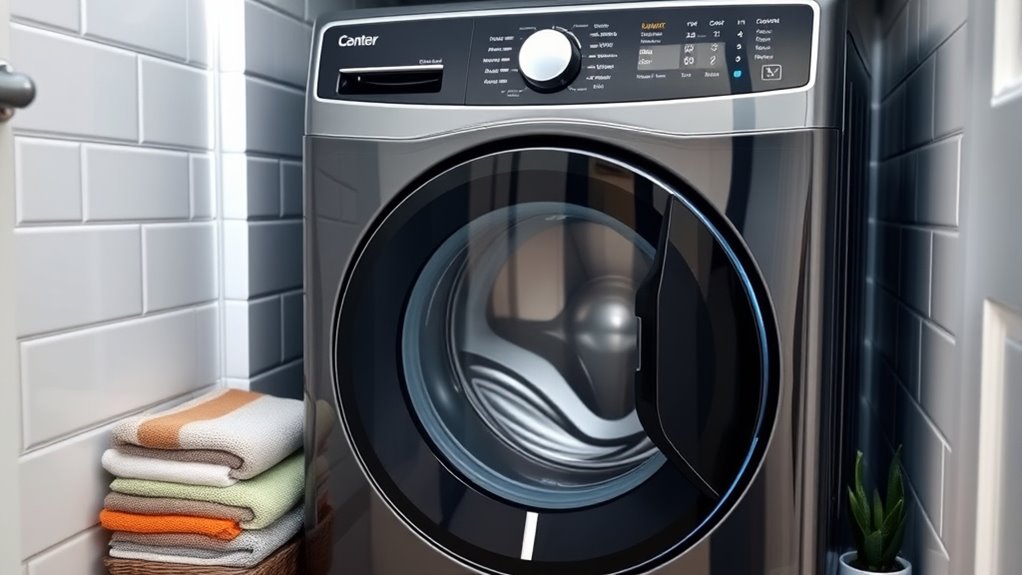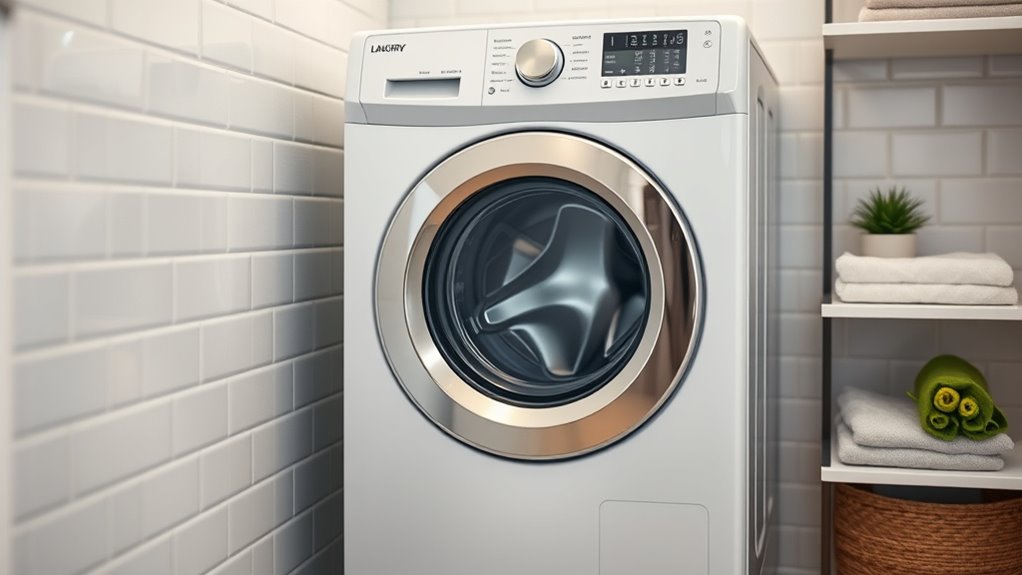Washer-dryer combos are a great space-saving solution if you live in a small home or apartment. They combine washing and drying functions in one appliance, freeing up valuable space. While they’re generally quiet and energy-efficient, longer cycle times and some noise during drying can be a drawback. If you want to maximize your limited space without sacrificing convenience, these units might be just what you need. Keep exploring to see if they’re the right fit for you.
Key Takeaways
- They save space by combining washing and drying in one appliance, ideal for small living areas.
- While energy-efficient, longer cycles may offset some savings and affect overall utility costs.
- Generally quieter than separate units, but noise during drying can be disruptive in open spaces.
- Extended cycle times may reduce convenience for quick laundry needs.
- Suitable for compact lifestyles, but performance and noise levels vary by model and user needs.

Are washer-dryer combos the perfect solution for small spaces and busy lifestyles? If you’re tight on space, these all-in-one appliances can seem like a blessing. They eliminate the need for separate machines, freeing up precious square footage. But before you commit, it’s worth considering how they perform in key areas like energy efficiency and noise levels. These factors can markedly impact your daily routine and utility bills.
When it comes to energy efficiency, washer-dryer combos are generally designed to save power and water. Since they operate as a single unit, they often use less energy than running separate machines. Many models come with energy-saving settings, helping you reduce your carbon footprint and lower your utility bills. However, it’s important to pick a model with high energy efficiency ratings, especially if you plan to use it frequently. Keep in mind that some combos might take longer to wash and dry, which could offset some of the energy savings if you’re running multiple cycles per week.
Noise levels are another vital consideration, especially if your living space is open-plan or close to bedrooms. Washer-dryer combos tend to be quieter than traditional separate units, mainly because they’re usually designed with noise reduction in mind. Still, some models can produce noticeable sounds during operation, particularly during the drying cycle. This can be disruptive if you’re working from home or trying to relax while laundry runs. Look for units with sound insulation features or those labeled as “quiet” or “low noise,” and consider their placement within your home. Placing the machine in a closet or a partitioned nook can help contain noise and prevent it from disturbing your daily activities.
Another aspect to think about is the cycle times. Because washer-dryer combos do both tasks sequentially, they often take longer than separate machines. If you’re someone who needs laundry done quickly, this could be a drawback. But if you’re patient and prefer the convenience of a single appliance, the longer cycle might not be an issue. Just remember that extended drying times could impact your energy consumption, especially if you tend to wash multiple loads in a day.
In the end, washer-dryer combos offer a practical space-saving solution without necessarily sacrificing too much on efficiency or noise. They’re ideal if you value convenience and have limited room, but it’s essential to choose a model that balances performance with your specific needs. By paying attention to energy efficiency ratings and noise levels, you can enjoy the benefits of a compact laundry setup that fits seamlessly into your busy, small-space lifestyle.
Frequently Asked Questions
How Long Does a Typical Washing and Drying Cycle Take?
A typical washing and drying cycle usually takes around 2 to 3 hours, depending on the cycle duration and drying time. You might notice that wash cycles are generally quicker, around 30 to 60 minutes, while drying can add another hour or more. Keep in mind that cycle duration varies based on load size, fabric type, and settings. If you’re in a hurry, quick wash and dry options can save you time.
Are Washer-Dryer Combos Energy Efficient Compared to Separate Units?
You might wonder if washer-dryer combos are energy efficient compared to separate units. Generally, they tend to use more energy per cycle because they perform both functions in one machine, leading to higher energy consumption. This impacts the environmental impact, as they often consume more electricity and water. However, their space-saving design may offset some drawbacks, especially if you have limited room, but for energy savings, separate units usually perform better.
Can Washer-Dryer Combos Handle Large or Bulky Items Effectively?
Imagine trying to wash a bulky comforter in a washer-dryer combo. These units can handle heavy loads and bulky fabrics, but they might struggle with larger items like thick blankets or oversized jackets. While they’re convenient for small to medium laundry tasks, for large or bulky items, you may find they don’t clean as thoroughly or dry evenly. If you frequently wash big loads, separate machines could be more effective.
What Maintenance Is Required to Keep a Combo Unit Functioning Well?
To keep your washer-dryer combo running smoothly, you should regularly clean the lint filter to prevent buildup and guarantee efficient drying. Use the right detergent types to avoid residue that can clog the system. Check hoses and seals periodically for leaks or damage, and run a maintenance cycle with a cleaning agent if your model recommends it. These steps help maintain ideal performance and extend your unit’s lifespan.
Do Washer-Dryer Combos Require Special Plumbing or Electrical Setups?
You don’t need major plumbing modifications or special electrical requirements for a washer-dryer combo. Most units connect to your existing water supply and drain, and only need a standard electrical outlet, usually 120V. However, it’s smart to check your unit’s specifications and your home’s setup to verify compatibility. Some models might require minor adjustments, but generally, they’re designed for straightforward installation without extensive plumbing or electrical work.
Conclusion
A washer-dryer combo is like a clever puzzle piece, fitting neatly into your space but sometimes sacrificing a little of the full picture. While it’s perfect for squeezing laundry into tight spots, don’t expect it to handle heavy loads or quick cycles with the same finesse as separate machines. Think of it as a trusty sidekick—great for convenience, but not the hero for every laundry adventure. Weigh your needs carefully before making this compact compromise.









